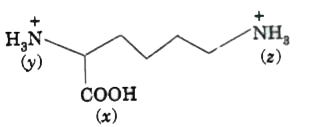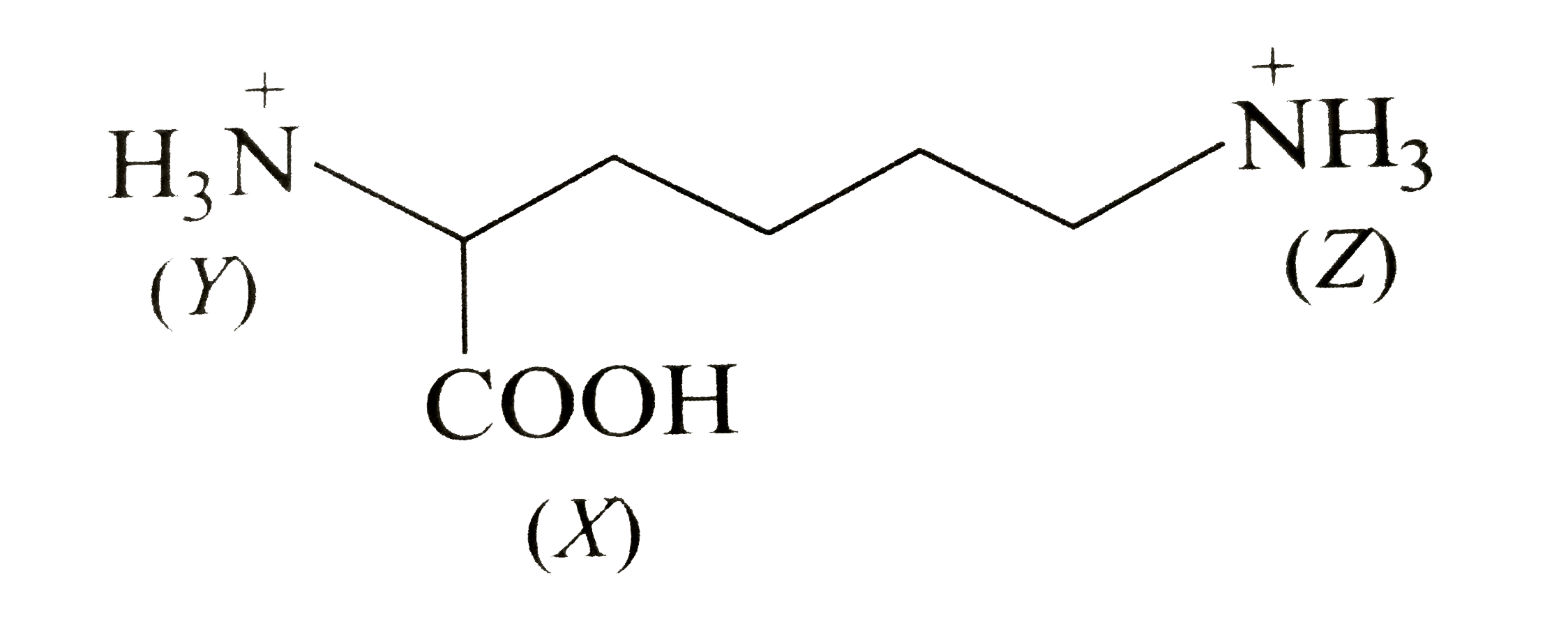A hydrocarbon, ‘X’(C3H4) decolourise bromine in carbon tetrachloride forming ‘Y’ . ‘X’ gave a red precipitate of a compound ‘Z’ with ammonical cuprous chloride and formed a carbonyl compound with dilute sulphuric acid in the presence of Hg+2 ions. X, Y, and Z are given by the set -
CH2=C=CH2,CH2Br–CBr2–CH2Br,CH3–C≡C–Cu
CH3–C≡CH,CH3–CBr2–CHBr2,CH3–C≡C–Cu
CH3–C≡CH,CH3–CBr=CHBr,CH2Cu–C≡CH
CH2=C=CH2,CH2Br–CH=CHBr,CH3–C≡C–Cu
The correct Answer is:B
To solve the problem step by step, we will analyze the given information about hydrocarbon X(C3H4) and its reactions.
Step 1: Identify the structure of hydrocarbon X
Given that X has the molecular formula C3H4, we can calculate its degree of unsaturation (double bond equivalent) using the formula:
\(
\text{Degree of Unsaturation} = \frac{(2C + 2 - H)}{2}
\)
Substituting the values:
\(
\text{Degree of Unsaturation} = \frac{(2 \times 3 + 2 - 4)}{2} = \frac{(6 + 2 - 4)}{2} = \frac{4}{2} = 2
\)
This indicates that X contains two double bonds or one triple bond.
Step 2: Determine the type of hydrocarbon
Since X decolorizes bromine in carbon tetrachloride, it indicates that X is an alkyne (specifically a terminal alkyne). The structure can be represented as:
\(
\text{X} = \text{CH}_3\text{C} \equiv \text{C} \text{H}
\)
Step 3: Identify compound Y
When X reacts with bromine in carbon tetrachloride, it undergoes an addition reaction, resulting in a dibromo compound. The reaction can be represented as:
\(
\text{CH}_3\text{C} \equiv \text{C} \text{H} + \text{Br}_2 \rightarrow \text{CH}_3\text{CBr}_2\text{CBr}_2\text{H}
\)
This compound Y is a colorless tetrabromoalkene.
Step 4: Identify compound Z
The hydrocarbon X reacts with ammoniacal cuprous chloride, which is a test for terminal alkynes. The reaction produces a red precipitate, which is a copper(I) acetylide. The reaction can be represented as:
\(
\text{CH}_3\text{C} \equiv \text{C} \text{H} + \text{CuCl} + \text{NH}_3 \rightarrow \text{CH}_3\text{C} \equiv \text{C-Cu} + \text{NH}_4\text{Cl}
\)
Thus, compound Z is CH3C≡C−Cu.
Step 5: Identify the carbonyl compound formed
When X is treated with dilute sulfuric acid in the presence of Hg2+ ions, it forms a carbonyl compound through hydration of the alkyne. The reaction can be represented as:
\(
\text{CH}_3\text{C} \equiv \text{C} \text{H} + \text{H}_2\text{SO}_4 + \text{Hg}^{2+} \rightarrow \text{CH}_3\text{C}(=O)\text{H}
\)
This results in the formation of acetone (or propan-2-one).
Final Summary of Compounds
- X: CH3C≡CH (1-butyne)
- Y: CH3CBr2CBr2H (tetrabromoalkene)
- Z: CH3C≡C−Cu (copper(I) acetylide)
Given that X has the molecular formula C3H4, we can calculate its degree of unsaturation (double bond equivalent) using the formula:
\text{Degree of Unsaturation} = \frac{(2C + 2 - H)}{2}
\)
\text{Degree of Unsaturation} = \frac{(2 \times 3 + 2 - 4)}{2} = \frac{(6 + 2 - 4)}{2} = \frac{4}{2} = 2
\)
Since X decolorizes bromine in carbon tetrachloride, it indicates that X is an alkyne (specifically a terminal alkyne). The structure can be represented as:
\text{X} = \text{CH}_3\text{C} \equiv \text{C} \text{H}
\)
When X reacts with bromine in carbon tetrachloride, it undergoes an addition reaction, resulting in a dibromo compound. The reaction can be represented as:
\text{CH}_3\text{C} \equiv \text{C} \text{H} + \text{Br}_2 \rightarrow \text{CH}_3\text{CBr}_2\text{CBr}_2\text{H}
\)
The hydrocarbon X reacts with ammoniacal cuprous chloride, which is a test for terminal alkynes. The reaction produces a red precipitate, which is a copper(I) acetylide. The reaction can be represented as:
\text{CH}_3\text{C} \equiv \text{C} \text{H} + \text{CuCl} + \text{NH}_3 \rightarrow \text{CH}_3\text{C} \equiv \text{C-Cu} + \text{NH}_4\text{Cl}
\)
When X is treated with dilute sulfuric acid in the presence of Hg2+ ions, it forms a carbonyl compound through hydration of the alkyne. The reaction can be represented as:
\text{CH}_3\text{C} \equiv \text{C} \text{H} + \text{H}_2\text{SO}_4 + \text{Hg}^{2+} \rightarrow \text{CH}_3\text{C}(=O)\text{H}
\)
- X: CH3C≡CH (1-butyne)
- Y: CH3CBr2CBr2H (tetrabromoalkene)
- Z: CH3C≡C−Cu (copper(I) acetylide)
Topper's Solved these Questions
- BOOK - MOTIONCHAPTER - HYDROCARBON EXERCISE - Exercise - 2 (Level-I)29videos
HYDROCARBON
- BOOK - MOTIONCHAPTER - HYDROCARBON EXERCISE - Exercise - 314videos
HYDROCARBON
- BOOK - MOTIONCHAPTER - HYDROCARBON EXERCISE - QUESTIONS6videos
HYDROCARBON
- BOOK - MOTIONCHAPTER - GRIGNARD REAGENTEXERCISE - EXERCISE-216videos
GRIGNARD REAGENT
- BOOK - MOTIONCHAPTER - IONIC EQUILIBRUIMEXERCISE - Exercise -4 (Level -II)14videos
IONIC EQUILIBRUIM
Similar Questions
A hydrocarbons C4H8, neither decolourised bromine in carbon tetrachloride nor reacted wiith HBr. When heated to 473 K with hydrogen in presence of a nickel catalyst, a new hydrocarbon, C4H10, was formed. What was the original hydrocarbon?
View SolutionA compound 'X' has a formula C3H6. It decolourises bromine water. Write the chemical name of 'X'.
View Solution
Knowledge Check
- Question 1 - Select One

In the compound given below the correct order of the acidity of the position X, Y and Z isAZ>X>YBX>Y>ZCX>Z>YDY>X>Z - Question 2 - Select One
In the compound given below :

the correct order of acidity of the position x,y, and z isAz>z>yBx>y>zCx>z>yDy>z>z - Question 3 - Select One
A compound is soluble in conc. H2SO4. It does not decolourise bromine in carbon tetrachloride but is oxidised by chromic abhydride in aqueous sulphuric acid with in two seconds, turning orange solution to blue, green and then opaque. The original compound is
Aa primary alcoholBa tertiary alcoholCan alkeneDan ether.
In the compound given below: the correct order of acidity of the positions

(X), (Y) and (Z) is :View SolutionIn the compound given below
 The correct order of acidity of the positions (X),(Y) and (Z) is View Solution
The correct order of acidity of the positions (X),(Y) and (Z) is View SolutionA chloro compound (A) showed the following properties,
i. decolourised bromine in Cl4
(ii). Absorbed hydrogen catalytically.
(iii). Gave a red precipitate with ammoniacal cuprous chloride ltbr> (iv). When vaporised 1.49 gm of (A) gave 448 ml of vapours at STP. Identify (A) and write doen the equiation for the reaction is step 3.View SolutionA hydrocarbon X with molecular fomula C4H6 decolorizes bromine water and forms a white precipitate in ethanolic AgNO3 solution. Treatment of X with HgCl2 in aqueous H2SO4 produces a compounds, which gives a yellow precipitate when treated with I2 and NaOH. The structure of X is :
View Solution3-hydroxybutanal formed when X reacts whith Y in dilute Z solution. What are X, Y, and Z?
View Solution

